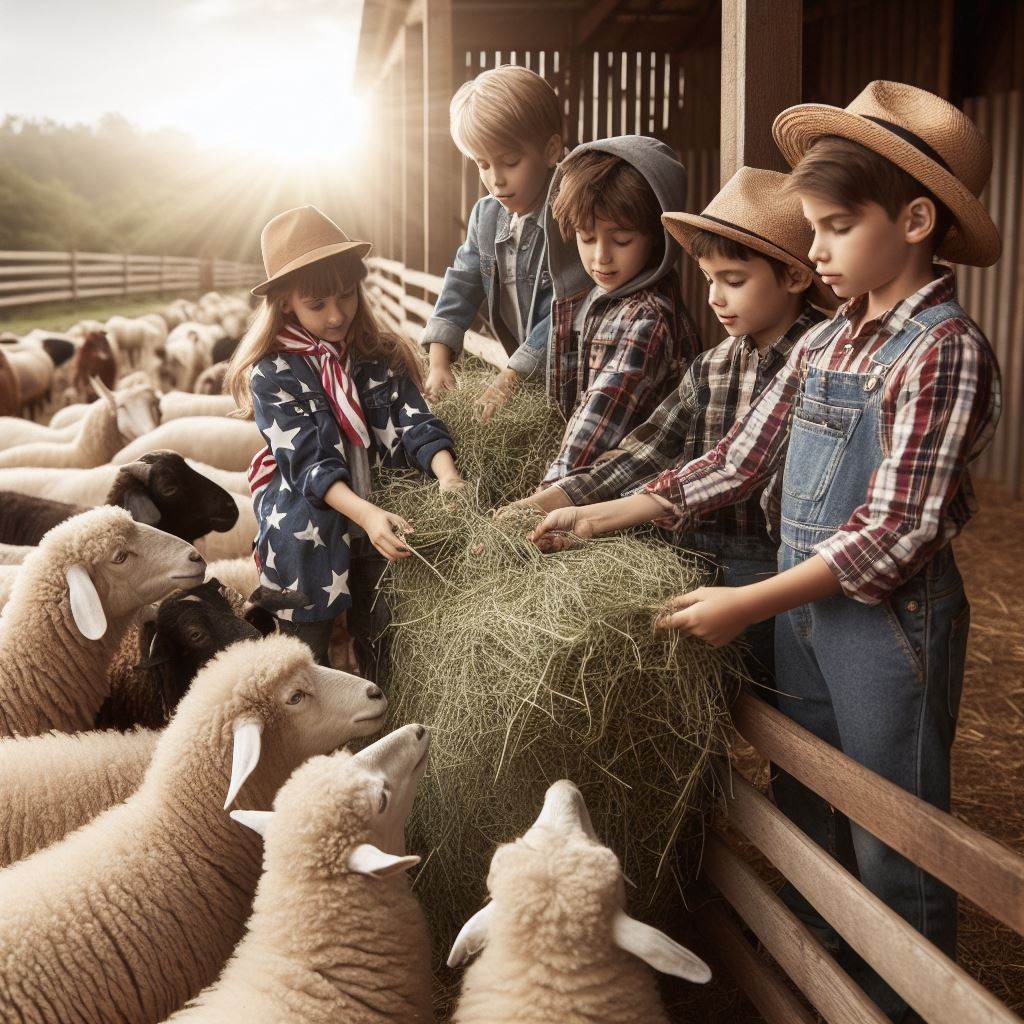Introduction
Grazing plans are vital for small farms because they ensure efficient use of available pastureland.
A grazing plan can be defined as a comprehensive strategy that outlines the management of livestock grazing on a farm.
A. Benefits of Grazing Plans for Small Farms
- Optimal Forage Utilization: Grazing plans help small farms maximize the utilization of available forage, leading to improved animal nutrition.
- Sustainable Land Management: By implementing a grazing plan, small farmers can prevent overgrazing and soil degradation, promoting sustainable land use.
- Cost Reduction: Proper pasture management through grazing plans reduces the need for supplementary feeds, minimizing production costs.
- Improved Animal Health: Grazing plans allow for rotational grazing, preventing the spread of parasites and diseases among livestock.
B. Components of a Grazing Plan
- Grazing Goals and Objectives: Farmers need to clearly define their objectives, such as optimizing forage production or maintaining biodiversity.
- Pasture Inventory and Assessment: Assessing the condition and carrying capacity of pastures helps determine the appropriate stocking rates.
- Rotational Grazing Schedule: Dividing pastures into paddocks and implementing a rotational grazing schedule ensures even forage utilization and allows for pasture rest and regrowth.
- Monitoring and Adjustments: Regular monitoring of pasture conditions and animal performance enables farmers to make necessary adjustments to the grazing plan.
Implementing a grazing plan is essential for small farms to maximize pastureland efficiency, sustainably manage land, and promote animal health and productivity.
Benefits of Grazing Plans for Small Farms
A grazing plan is a crucial tool for small farms seeking to improve their pasture management, optimize animal health, and minimize production costs.
By implementing a well-designed grazing plan, farmers can reap numerous benefits while efficiently utilizing their available land.
A. Improves pasture management
One of the primary advantages of a grazing plan is its ability to improve pasture management.
Overgrazing can be a detrimental issue that leads to the degradation of both pasture quality and quantity.
By carefully planning and controlling grazing patterns, farmers can prevent overgrazing, allowing their pastures to thrive.
Furthermore, implementing a grazing plan enhances soil fertility.
By utilizing rotational grazing and giving pastures adequate rest and recovery periods, the soil can replenish its nutrient levels.
This, in turn, promotes healthier and more productive pastures, providing ample forage for grazing animals.
B. Optimizes animal health and performance
A well-executed grazing plan directly contributes to optimal animal health and performance.
Managed rotational grazing ensures that animals always have access to fresh, nutritious forage, improving their overall diet and health.
By moving animals between different grazing areas, farmers can ensure that pastures are not overgrazed and maintain a constant supply of high-quality forage.
Additionally, a grazing plan enables balanced nutrition for animals.
Transform Your Agribusiness
Unlock your farm's potential with expert advice tailored to your needs. Get actionable steps that drive real results.
Get StartedBy offering a variety of grazing options and preventing selective grazing, farmers can ensure that all nutritional needs are met.
This results in healthier animals, better weight gain, and improved productivity.
C. Minimizes production costs
A cost-effective farming operation is crucial for small farms. Implementing a grazing plan can significantly minimize production costs.
One of the main areas where savings occur is in feed expenses.
As animals obtain a considerable portion of their diet from grazing, farmers can reduce their reliance on expensive supplemental feed.
Furthermore, a well-managed grazing plan can lead to decreased veterinary costs.
By providing animals with a more natural and stress-free environment, overall health and disease resistance are improved.
This reduces the need for medical interventions and veterinary treatments, resulting in cost savings for the farm.
Therefore, a grazing plan offers a range of benefits for small farms.
By improving pasture management, optimizing animal health and performance, and minimizing production costs, farmers can effectively utilize their land while operating in an efficient and sustainable manner.
Read: Pasture Weeds: Identification & Control
Components of an Effective Grazing Plan
A. Assessing forage availability and quality
- Understand carrying capacity by determining the maximum number of animals a farm can sustainably support.
- Conduct regular pasture analyses to evaluate the quality and quantity of available forage.
B. Allocating pasture and paddocks
- Determine the grazing area requirements based on the number of animals and their specific needs.
- Implement rotational grazing to optimize forage regrowth and minimize overgrazing.
C. Monitoring and adjusting grazing patterns
- Regularly inspect pastures to monitor forage growth, weed presence, and overall pasture condition.
- Adapt grazing patterns to seasonal changes in forage availability and growth rates.
D. Addressing supplementary feeding
- Evaluate the nutritional needs of the animals and determine if supplementary feeding is necessary.
- Properly distribute supplementary feed to prevent competition and ensure all animals receive adequate nutrition.
A well-designed grazing plan considers all these components to ensure sustainable forage utilization, optimal livestock health, and increased farm productivity.
By following these guidelines, small farms can effectively manage their grazing systems and maximize their resources.
Read: Erosion Control in Grazing Lands

Discover More: High-Tech Fencing Solutions for Livestock Safety
Delve into the Subject: Swine Diets Decoded: What Your Pigs Need
Delve into the Subject: Climate Impact on Pig Farming
Developing Your Grazing Plan
Developing a grazing plan is crucial for small farms to ensure the optimal utilization of pasture resources while meeting the needs of livestock.
In this section, we will discuss the key factors to consider when developing your grazing plan.
A. Grazing goals and objectives
1. Defining desired outcomes
Before developing a grazing plan, it is important to clearly define your desired outcomes.
These outcomes could include improving pasture quality, increasing livestock weight gains, or optimizing forage production.
By having well-defined goals, you can tailor your grazing plan to achieve these specific objectives.
2. Consideration for livestock needs
When setting grazing goals, it is crucial to consider the specific needs of your livestock.
Different animals have varying grazing preferences and nutritional requirements.
Showcase Your Farming Business
Publish your professional farming services profile on our blog for a one-time fee of $200 and reach a dedicated audience of farmers and agribusiness owners.
Publish Your ProfileUnderstanding these needs will allow you to design a grazing plan that provides adequate forage and promotes the overall health and productivity of your livestock.
B. Utilizing grazing management techniques
1. Grazing systems
Implementing effective grazing systems is essential for small farms.
There are various grazing systems to choose from, such as rotational grazing, strip grazing, or intensive grazing.
Each system has its own advantages and considerations, and selecting the most suitable system will depend on factors like farm size, available pasture, and the number of livestock.
2. Resting periods
Resting periods are important for allowing pastures to recover and regenerate.
Overgrazing can lead to reduced pasture productivity and degradation.
By including appropriate resting periods in your grazing plan, you can ensure that your pastures have sufficient time to regrow, resulting in healthier forage and improved grazing efficiency.
C. Collaborating with professionals or consultants
1. Seeking guidance from agricultural specialists
Consulting with agricultural specialists, such as agronomists or livestock nutritionists, can provide valuable insights and expertise.
These professionals can assess your farm’s specific conditions and help you develop a grazing plan that maximizes productivity while addressing any challenges or limitations.
2. Attending workshops or training sessions
Continual education and learning are key to improving grazing management techniques.
Attending workshops, conferences, or training sessions dedicated to grazing practices can expand your knowledge and keep you updated with the latest advancements in the field.
Networking with other farmers and experts can also provide additional support and resources.
In essence, developing a grazing plan involves defining your goals, implementing appropriate grazing management techniques, and seeking guidance from professionals.
By carefully considering these factors and tailoring your grazing plan to your specific farm needs, you can achieve sustainable and productive grazing practices for your small farm.
Read: Boosting Pasture Yield: Top Techniques
Implementing and Maintaining your Grazing Plan
A well-designed grazing plan is essential for the success and sustainability of small farms.
However, implementing and maintaining the plan requires careful attention to various aspects of pasture management.
In this section, we will explore the key steps involved in ensuring the proper execution and ongoing maintenance of your grazing plan.
A. Prioritizing pasture maintenance
- Weed control: Regularly inspect your pastures and promptly address any weed infestations to prevent them from spreading.
- Fertilization and soil amendments: Conduct soil tests and apply appropriate fertilizers and amendments to optimize pasture productivity.
B. Rotational grazing management
- Designing grazing rotations: Divide your pastures into sections and implement a rotational system where animals are moved from one section to another.
- Adjusting stocking rates: Keep a close eye on forage availability and adjust the number of animals grazing accordingly to prevent overgrazing.
C. Continual monitoring and adaptations
- Assessing forage growth: Regularly monitor the growth of your pastures to determine when it’s time to rotate animals and ensure adequate forage availability.
- Adapting plan to changing conditions: Be flexible and ready to modify your grazing plan based on weather conditions, seasonal changes, and other evolving factors.
Implementing and maintaining a grazing plan requires commitment and ongoing effort.
By following these key steps, you can ensure that your pastures remain healthy, productive, and sustainable for the long term.
Read: Livestock Health: Pasture-Based Tips
Conclusion
A. Recap of the importance and benefits of grazing plans for small farms
Grazing plans are vital for small farms as they promote sustainable land management, enhance soil health, and ensure adequate nutrition for livestock.
They also lead to increased profitability by reducing feeding costs and improving overall farm efficiency.
B. Encouragement and resources for implementing grazing plans
If you’re a small farm owner looking to implement a grazing plan, there are various resources available.
Local agricultural extension offices, farming associations, and online platforms offer guidance, educational materials, and support.
Connecting with experienced farmers in your area can also provide valuable insights and advice.
C. Final thoughts and call to action for small farm owners to develop their grazing plans
Don’t underestimate the power of a well-designed grazing plan for your small farm.
By carefully managing your pasture, you can optimize livestock health, protect the environment, and improve your bottom line.
Take the first step towards creating your grazing plan today and start reaping the benefits for years to come.




